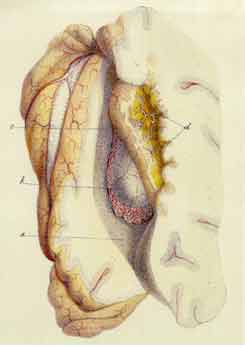|
Plate XI.
Click image to enlarge
 |
|
Carswell's 1838 Characterization of the compartmentation of a large
paraventricular cerebral lesion according to a major cerebral vessel
involvement:
Softening inside a cerebral hemisphere from arterial obstruction (a, lateral
ventricle laid open; b, thalamus; c, corpus striatum; the upper half of the
latter central cerebral nucleus is, corresponding to the ramifications of
two smaller, obliterated arteries (d), converted into a soft pulp).
|
Differentiation from Multiple Sclerosis:
Contrary to the surging up of "Dawson's fingers" directly off of the
ventricular border, periventricular lesions caused by arterial obstruction, in
keeping with the local arteries' patterns of ramification, characteristically
either bluntly abutt onto, or end at a certain distance from, the cerebral
ventricles.
|
|
Historical Relevance:
This drawing inaugurated a progressive refinement in the delimitation of
different cerebral (and spinal) vascular territories and of the corresponding
cerebral (and spinal) lesion patterns, thus paving the way to a clearer
discrimination and understanding of the genesis of the diverse vessel-related
damages to brain and spinal cord.
|